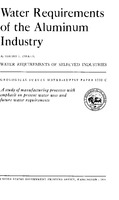Water requirements of the aluminum industry
Links
- Document: Report (2.27 MB pdf)
- Larger Work: This publication is Chapter C of Water requirements of selected industries
- Download citation as: RIS | Dublin Core
Abstract
Aluminum is unique among metals in the way it is obtained from its ore. The first step is to produce alumina, a white powder that bears no resemblance to the bauxite from which it is derived or to the metallic aluminum to which it is reduced by electrolytic action in a second step. Each step requires a complete plant facility, and the plants may be adjacent or separated by as much as the width of the North American continent. Field investigations sf every alumina plant and reduction works in the United States were undertaken to determine the industry's water use. Detailed studies were made of process and plant layout so that a water balance could be made for each plant to determine not only the gross water intake but also an approximation of the consumptive use of water.
Water requirements of alumina plants range from 0.28 to 1.10 gallons per pound of alumina; the average for the industry is 0.66 gallon. Water requirements of reduction works vary considerably more, ranging from 1.24 to 36.33 gallons per pound of aluminum, and average 14.62 gallons.
All alumina plants in the United States derive alumina from bauxite by the Bayer process or by the Combination process, a modification of the Bayer process. Although the chemical process for obtaining alumina from bauxite is essentially the same at all plants, different procedures are employed to cool the sodium aluminate solution before it enters the precipitating tanks and to concentrate it by evaporation of some of the water in the solution. Where this evaporation takes place in a cooling tower, water in the solution is lost to the atmosphere as water vapor and so is used consumptively. In other plants, the quantity of solution in the system is controlled by evaporation in a multiple-effect evaporator where practically all vapor distilled out of the solution is condensed to water that may be reused. The latter method is used in all recently constructed alumina plants, and some older plants are replacing cooling towers with multiple-effect evaporators.
All reduction works in the United States use the Hall process, but the variation in water requirements is even greater than the variation at alumina plants, and, further, the total daily water requirement for all reduction works is more than 9 times the total daily requirement of all alumina plants. Many reduction works use gas scrubbers, but some do not. As gas scrubbing is one of the principal water uses in reduction works, the manner in which wash water is used, cooled, and reused accounts in large measure for the variation in water requirements.
Although the supply of water for all plants but one was reported by the management to be ample for all plant needs, the economic factor of the cost of water differs considerably among plants. It is this factor that accounts in large measure for the widely divergent slant practices. Plant capacity alone has so little effect on plant water requirements that other conditions such as plant operation based on the cost of water, plant location, and the need for conservation of water mask any economy inherent in plant size.
| Publication type | Report |
|---|---|
| Publication Subtype | USGS Numbered Series |
| Title | Water requirements of the aluminum industry |
| Series title | Water Supply Paper |
| Series number | 1330 |
| Chapter | C |
| DOI | 10.3133/wsp1330C |
| Year Published | 1956 |
| Language | English |
| Publisher | U.S. Government Printing Office |
| Description | v, 137 p. |
| Larger Work Title | Water requirements of selected industries |
| First page | 103 |
| Last page | 139 |


